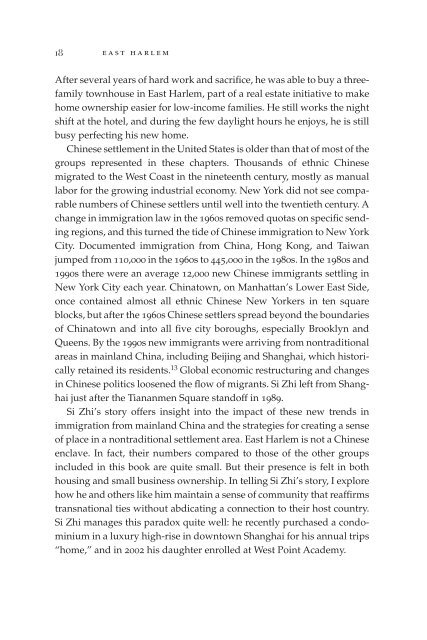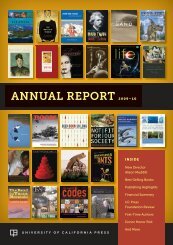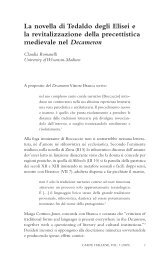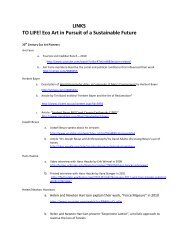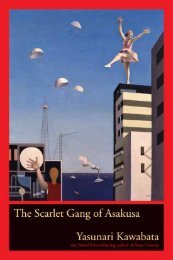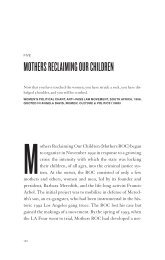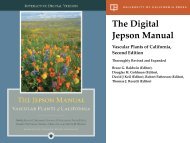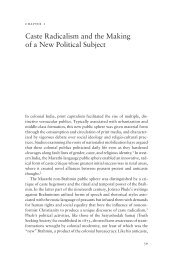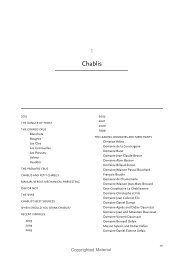Read Chapter 1 (PDF) - University of California Press
Read Chapter 1 (PDF) - University of California Press
Read Chapter 1 (PDF) - University of California Press
You also want an ePaper? Increase the reach of your titles
YUMPU automatically turns print PDFs into web optimized ePapers that Google loves.
18<br />
east harlem<br />
After several years <strong>of</strong> hard work and sacrifice, he was able to buy a threefamily<br />
townhouse in East Harlem, part <strong>of</strong> a real estate initiative to make<br />
home ownership easier for low-income families. He still works the night<br />
shift at the hotel, and during the few daylight hours he enjoys, he is still<br />
busy perfecting his new home.<br />
Chinese settlement in the United States is older than that <strong>of</strong> most <strong>of</strong> the<br />
groups represented in these chapters. Thousands <strong>of</strong> ethnic Chinese<br />
migrated to the West Coast in the nineteenth century, mostly as manual<br />
labor for the growing industrial economy. New York did not see comparable<br />
numbers <strong>of</strong> Chinese settlers until well into the twentieth century. A<br />
change in immigration law in the 1960s removed quotas on specific sending<br />
regions, and this turned the tide <strong>of</strong> Chinese immigration to New York<br />
City. Documented immigration from China, Hong Kong, and Taiwan<br />
jumped from 110,000 in the 1960s to 445,000 in the 1980s. In the 1980s and<br />
1990s there were an average 12,000 new Chinese immigrants settling in<br />
New York City each year. Chinatown, on Manhattan’s Lower East Side,<br />
once contained almost all ethnic Chinese New Yorkers in ten square<br />
blocks, but after the 1960s Chinese settlers spread beyond the boundaries<br />
<strong>of</strong> Chinatown and into all five city boroughs, especially Brooklyn and<br />
Queens. By the 1990s new immigrants were arriving from nontraditional<br />
areas in mainland China, including Beijing and Shanghai, which historically<br />
retained its residents. 13 Global economic restructuring and changes<br />
in Chinese politics loosened the flow <strong>of</strong> migrants. Si Zhi left from Shanghai<br />
just after the Tiananmen Square stand<strong>of</strong>f in 1989.<br />
Si Zhi’s story <strong>of</strong>fers insight into the impact <strong>of</strong> these new trends in<br />
immigration from mainland China and the strategies for creating a sense<br />
<strong>of</strong> place in a nontraditional settlement area. East Harlem is not a Chinese<br />
enclave. In fact, their numbers compared to those <strong>of</strong> the other groups<br />
included in this book are quite small. But their presence is felt in both<br />
housing and small business ownership. In telling Si Zhi’s story, I explore<br />
how he and others like him maintain a sense <strong>of</strong> community that reaffirms<br />
transnational ties without abdicating a connection to their host country.<br />
Si Zhi manages this paradox quite well: he recently purchased a condominium<br />
in a luxury high-rise in downtown Shanghai for his annual trips<br />
“home,” and in 2002 his daughter enrolled at West Point Academy.


